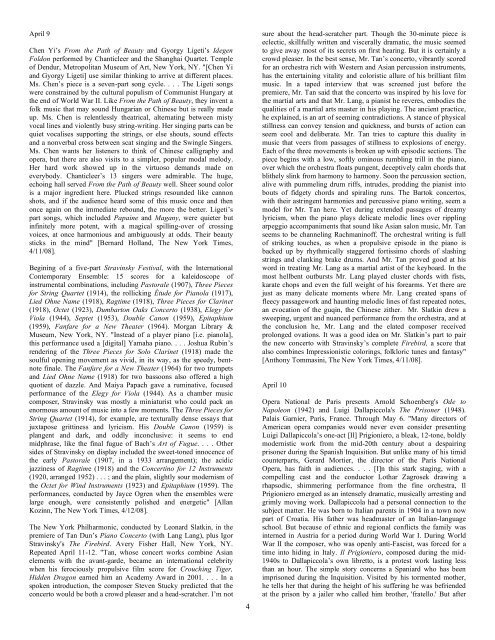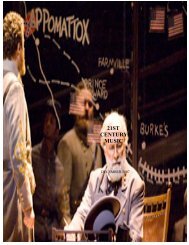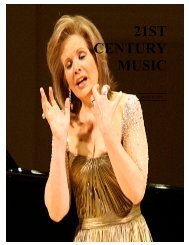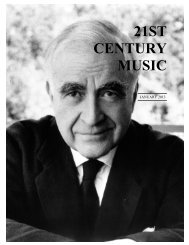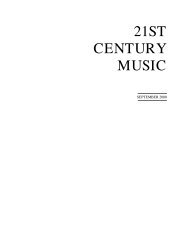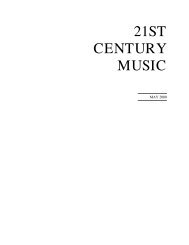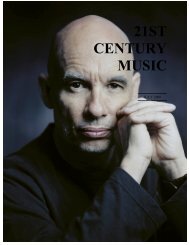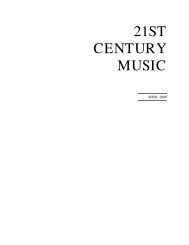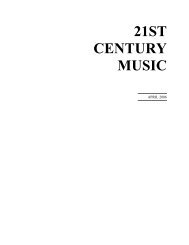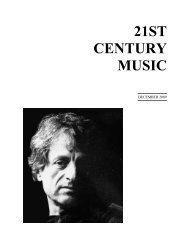Songs of Igor Stravinsky - 21st Century Music
Songs of Igor Stravinsky - 21st Century Music
Songs of Igor Stravinsky - 21st Century Music
You also want an ePaper? Increase the reach of your titles
YUMPU automatically turns print PDFs into web optimized ePapers that Google loves.
April 9<br />
Chen Yi’s From the Path <strong>of</strong> Beauty and Gyorgy Ligeti’s Idegen<br />
Foldon performed by Chanticleer and the Shanghai Quartet. Temple<br />
<strong>of</strong> Dendur, Metropolitan Museum <strong>of</strong> Art, New York, NY. "[Chen Yi<br />
and Gyorgy Ligeti] use similar thinking to arrive at different places.<br />
Ms. Chen’s piece is a seven-part song cycle. . . . The Ligeti songs<br />
were constrained by the cultural populism <strong>of</strong> Communist Hungary at<br />
the end <strong>of</strong> World War II. Like From the Path <strong>of</strong> Beauty, they invent a<br />
folk music that may sound Hungarian or Chinese but is really made<br />
up. Ms. Chen is relentlessly theatrical, alternating between misty<br />
vocal lines and violently busy string-writing. Her singing parts can be<br />
quiet vocalises supporting the strings, or else shouts, sound effects<br />
and a nonverbal cross between scat singing and the Swingle Singers.<br />
Ms. Chen wants her listeners to think <strong>of</strong> Chinese calligraphy and<br />
opera, but there are also visits to a simpler, popular modal melody.<br />
Her hard work showed up in the virtuoso demands made on<br />
everybody. Chanticleer’s 13 singers were admirable. The huge,<br />
echoing hall served From the Path <strong>of</strong> Beauty well. Sheer sound color<br />
is a major ingredient here. Plucked strings resounded like cannon<br />
shots, and if the audience heard some <strong>of</strong> this music once and then<br />
once again on the immediate rebound, the more the better. Ligeti’s<br />
part songs, which included Papaine and Magany, were quieter but<br />
infinitely more potent, with a magical spilling-over <strong>of</strong> crossing<br />
voices, at once harmonious and ambiguously at odds. Their beauty<br />
sticks in the mind" [Bernard Holland, The New York Times,<br />
4/11/08].<br />
Begining <strong>of</strong> a five-part <strong>Stravinsky</strong> Festival, with the International<br />
Contemporary Ensemble: 15 scores for a kaleidoscope <strong>of</strong><br />
instrumental combinations, including Pastorale (1907), Three Pieces<br />
for String Quartet (1914), the rollicking Étude for Pianola (1917),<br />
Lied Ohne Name (1918), Ragtime (1918), Three Pieces for Clarinet<br />
(1918), Octet (1923), Dumbarton Oaks Concerto (1938), Elegy for<br />
Viola (1944), Septet (1953), Double Canon (1959), Epitaphium<br />
(1959), Fanfare for a New Theater (1964). Morgan Library &<br />
Museum, New York, NY. "Instead <strong>of</strong> a player piano [i.e. pianola],<br />
this performance used a [digital] Yamaha piano. . . . Joshua Rubin’s<br />
rendering <strong>of</strong> the Three Pieces for Solo Clarinet (1918) made the<br />
soulful opening movement as vivid, in its way, as the speedy, bentnote<br />
finale. The Fanfare for a New Theater (1964) for two trumpets<br />
and Lied Ohne Name (1918) for two bassoons also <strong>of</strong>fered a high<br />
quotient <strong>of</strong> dazzle. And Maiya Papach gave a ruminative, focused<br />
performance <strong>of</strong> the Elegy for Viola (1944). As a chamber music<br />
composer, <strong>Stravinsky</strong> was mostly a miniaturist who could pack an<br />
enormous amount <strong>of</strong> music into a few moments. The Three Pieces for<br />
String Quartet (1914), for example, are texturally dense essays that<br />
juxtapose grittiness and lyricism. His Double Canon (1959) is<br />
plangent and dark, and oddly inconclusive: it seems to end<br />
midphrase, like the final fugue <strong>of</strong> Bach’s Art <strong>of</strong> Fugue. . . . Other<br />
sides <strong>of</strong> <strong>Stravinsky</strong> on display included the sweet-toned innocence <strong>of</strong><br />
the early Pastorale (1907, in a 1933 arrangement); the acidic<br />
jazziness <strong>of</strong> Ragtime (1918) and the Concertino for 12 Instruments<br />
(1920, arranged 1952) . . . ; and the plain, slightly sour modernism <strong>of</strong><br />
the Octet for Wind Instruments (1923) and Epitaphium (1959). The<br />
performances, conducted by Jayce Ogren when the ensembles were<br />
large enough, were consistently polished and energetic" [Allan<br />
Kozinn, The New York Times, 4/12/08].<br />
The New York Philharmonic, conducted by Leonard Slatkin, in the<br />
premiere <strong>of</strong> Tan Dun’s Piano Concerto (with Lang Lang), plus <strong>Igor</strong><br />
<strong>Stravinsky</strong>'s The Firebird. Avery Fisher Hall, New York, NY.<br />
Repeated April 11-12. "Tan, whose concert works combine Asian<br />
elements with the avant-garde, became an international celebrity<br />
when his ferociously propulsive film score for Crouching Tiger,<br />
Hidden Dragon earned him an Academy Award in 2001. . . . In a<br />
spoken introduction, the composer Steven Stucky predicted that the<br />
concerto would be both a crowd pleaser and a head-scratcher. I’m not<br />
4<br />
sure about the head-scratcher part. Though the 30-minute piece is<br />
eclectic, skillfully written and viscerally dramatic, the music seemed<br />
to give away most <strong>of</strong> its secrets on first hearing. But it is certainly a<br />
crowd pleaser. In the best sense, Mr. Tan’s concerto, vibrantly scored<br />
for an orchestra rich with Western and Asian percussion instruments,<br />
has the entertaining vitality and coloristic allure <strong>of</strong> his brilliant film<br />
music. In a taped interview that was screened just before the<br />
premiere, Mr. Tan said that the concerto was inspired by his love for<br />
the martial arts and that Mr. Lang, a pianist he reveres, embodies the<br />
qualities <strong>of</strong> a martial arts master in his playing. The ancient practice,<br />
he explained, is an art <strong>of</strong> seeming contradictions. A stance <strong>of</strong> physical<br />
stillness can convey tension and quickness, and bursts <strong>of</strong> action can<br />
seem cool and deliberate. Mr. Tan tries to capture this duality in<br />
music that veers from passages <strong>of</strong> stillness to explosions <strong>of</strong> energy.<br />
Each <strong>of</strong> the three movements is broken up with episodic sections. The<br />
piece begins with a low, s<strong>of</strong>tly ominous rumbling trill in the piano,<br />
over which the orchestra floats pungent, deceptively calm chords that<br />
blithely slink from harmony to harmony. Soon the percussion section,<br />
alive with pummeling drum riffs, intrudes, prodding the pianist into<br />
bouts <strong>of</strong> fidgety chords and spiraling runs. The Bartok concertos,<br />
with their astringent harmonies and percussive piano writing, seem a<br />
model for Mr. Tan here. Yet during extended passages <strong>of</strong> dreamy<br />
lyricism, when the piano plays delicate melodic lines over rippling<br />
arpeggio accompaniments that sound like Asian salon music, Mr. Tan<br />
seems to be channeling Rachmanin<strong>of</strong>f. The orchestral writing is full<br />
<strong>of</strong> striking touches, as when a propulsive episode in the piano is<br />
backed up by rhythmically staggered fortissimo chords <strong>of</strong> slashing<br />
strings and clanking brake drums. And Mr. Tan proved good at his<br />
word in treating Mr. Lang as a martial artist <strong>of</strong> the keyboard. In the<br />
most hellbent outbursts Mr. Lang played cluster chords with fists,<br />
karate chops and even the full weight <strong>of</strong> his forearms. Yet there are<br />
just as many delicate moments where Mr. Lang created spans <strong>of</strong><br />
fleecy passagework and haunting melodic lines <strong>of</strong> fast repeated notes,<br />
an evocation <strong>of</strong> the guqin, the Chinese zither. Mr. Slatkin drew a<br />
sweeping, urgent and nuanced performance from the orchestra, and at<br />
the conclusion he, Mr. Lang and the elated composer received<br />
prolonged ovations. It was a good idea on Mr. Slatkin’s part to pair<br />
the new concerto with <strong>Stravinsky</strong>’s complete Firebird, a score that<br />
also combines Impressionistic colorings, folkloric tunes and fantasy"<br />
[Anthony Tommasini, The New York Times, 4/11/08].<br />
April 10<br />
Opera National de Paris presents Arnold Schoenberg's Ode to<br />
Napoleon (1942) and Luigi Dallapiccola's The Prisoner (1948).<br />
Palais Garnier, Paris, France. Through May 6. "Many directors <strong>of</strong><br />
American opera companies would never even consider presenting<br />
Luigi Dallapiccola’s one-act [Il] Prigioniero, a bleak, 12-tone, boldly<br />
modernistic work from the mid-20th century about a despairing<br />
prisoner during the Spanish Inquisition. But unlike many <strong>of</strong> his timid<br />
counterparts, Gerard Mortier, the director <strong>of</strong> the Paris National<br />
Opera, has faith in audiences. . . . [I]n this stark staging, with a<br />
compelling cast and the conductor Lothar Zagrosek drawing a<br />
rhapsodic, shimmering performance from the fine orchestra, Il<br />
Prigioniero emerged as an intensely dramatic, musically arresting and<br />
grimly moving work. Dallapiccola had a personal connection to the<br />
subject matter. He was born to Italian parents in 1904 in a town now<br />
part <strong>of</strong> Croatia. His father was headmaster <strong>of</strong> an Italian-language<br />
school. But because <strong>of</strong> ethnic and regional conflicts the family was<br />
interned in Austria for a period during World War I. During World<br />
War II the composer, who was openly anti-Fascist, was forced for a<br />
time into hiding in Italy. Il Prigioniero, composed during the mid-<br />
1940s to Dallapiccola’s own libretto, is a protest work lasting less<br />
than an hour. The simple story concerns a Spaniard who has been<br />
imprisoned during the Inquisition. Visited by his tormented mother,<br />
he tells her that during the height <strong>of</strong> his suffering he was befriended<br />
at the prison by a jailer who called him brother, 'fratello.' But after


